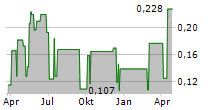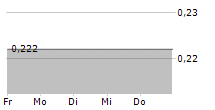
ADELAIDE, AUSTRALIA / ACCESSWIRE / September 30, 2024 /
HIGHLIGHTS
Follow up drilling to July 2024 Tarcoola JORC Mineral Resource Estimate (MRE) confirms new adjacent zones of shallow pit floor gold mineralisation, with key high-grade assays including:[1]
Hole ID | Interval (m) |
| Grade (g/t Au) |
| Depth (m) | Including |
TBM0212 | 5m | @ | 5.94 | from | 11m | 1m @ 23.8g/t Au |
TBM0209 | 4m | @ | 10.4 | from | 32m | 1m @ 34.4g/t Au |
TBM0215 | 6m | @ | 6.17 | from | 39m | 2m @ 13.4g/t Au |
TBM0215 | 5m | @ | 6.07 | from | 99m | 1m @ 28.3g/t Au |
TBM0213 | 7m | @ | 9.63 | from | 67m | 2m @ 28.0g/t Au |
Barton Gold Holdings Limited (ASX:BGD)(FRA:BGD3)(OTCQB:BGDFF) ( Barton or Company ) is pleased to confirm further high-grade open pit Perseverance Mine assays at the Tarcoola Gold Project ( Tarcoola) .
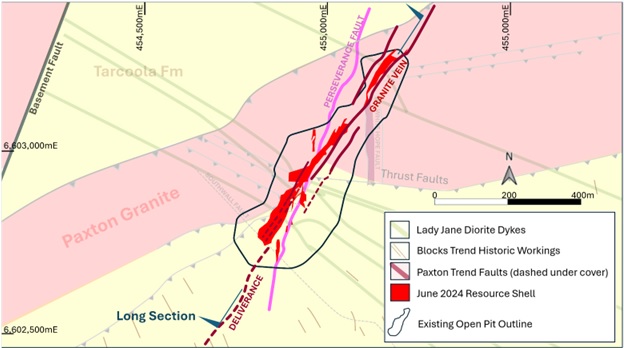
Commenting on the latest Perseverance Mine drilling results, Barton MD Alexander Scanlon said:
"We are pleased to confirm further high-grade mineralisation in the Perseverance Mine's open pit floor. This is expected to support the definition of additional JORC Resources and we plan to review potential extensions as we position our assets for a potential 'Stage 1' operation utilising our fully permitted Central Gawler Mill."
New pit floor gold zone
Following the definition of a shallow new JORC MRE of ~20koz @ ~2 g/t Au in the Perseverance Mine's open pit floor, Barton completed another 10 holes (882m) of follow up drilling during July 2024. [2 ] Assay results have confirmed another pit floor gold zone to the east of the July 2024 MRE block model .
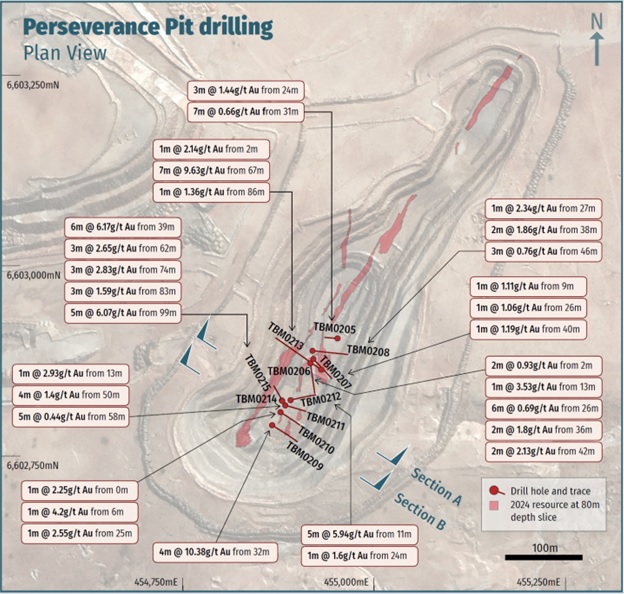
Hole ID | Interval (m) |
| Grade (g/t Au) |
| Depth (m) | Including |
TBM209 | 4m | @ | 10.4 | from | 32 | 1m @ 34.4g/t Au from 33m |
TBM211 | 4 | @ | 1.4 | from | 50 | 1m @ 2.27g/t Au from 50m & 1m @ 2.49g/t Au from 53m |
TBM212 | 5 | @ | 5.94 | from | 11 | 1m @ 23.8g/t Au from 12m |
TBM213 | 7 | @ | 9.63 | from | 67 | 2m @ 28.0g/t Au from 68m |
TBM215 | 6 | @ | 6.17 | from | 39 | 2m @ 13.4g/t Au from 40m |
and | 3 | @ | 2.65 | from | 62 |
|
and | 3 | @ | 2.83 | from | 74 |
|
and | 5 | @ | 6.07 | from | 99 | 1m @ 28.3g/t Au from 103m |
Table 1 - Key high-grade assays from July 2024 Perseverance Mine follow up RC drilling
Resource modelling and extensions
Drilling has focused on testing shallow zones of the pit floor suspected to host further gold mineralisation, with the goal to infill and extend the July 2024 MRE block model and convert additional JORC Resources.
The new mineralisation encountered in this drilling is shallow (within 10-100m of the pit floor) and located east of the July 2024 MRE block model mineralisation. It is therefore anticipated that these materials will increase the total number of gold ounces which could be recovered from the same development profile.
The Company is also reviewing modelled, but unclassified, extensions for potential follow up drilling.
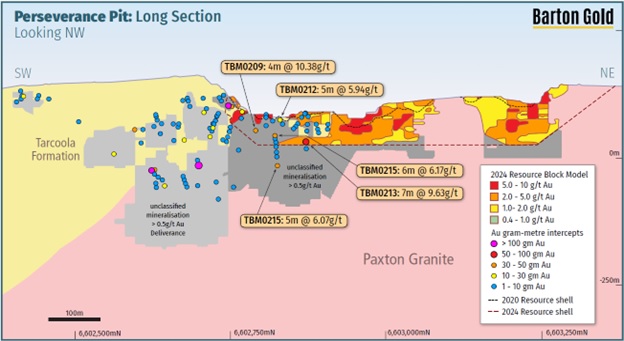
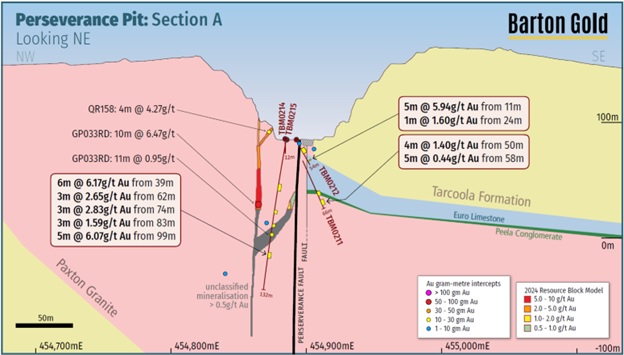
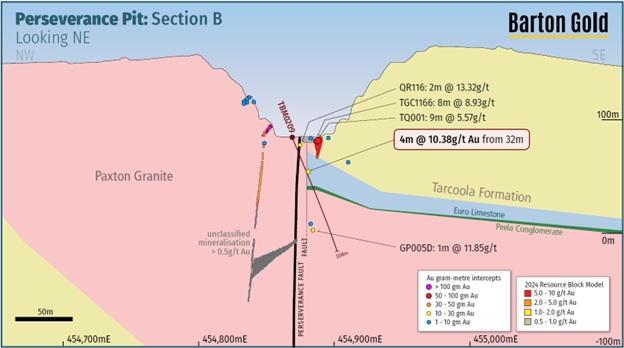
Current Tarcoola JORC Mineral Resources Estimate (MRE)
The Tarcoola JORC MRE was last updated during July 2024 as follows: [3]
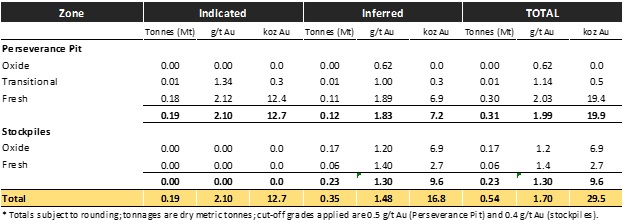
Table 2 - Tarcoola MRE (June 2024) 3
Authorised by the Board of Directors of Barton Gold Holdings Limited.
For further information, please contact:
Alexander Scanlon | Shannon Coates |
|
Competent Persons Statement
The information in this announcement that relates to Exploration Results for the Tarcoola Gold Project (including drilling, sampling, geophysical surveys and geological interpretation) is based upon, and fairly represents, information and supporting documentation compiled by Mr Marc Twining BSc (Hons). Mr Twining is an employee of Barton Gold Holdings Ltd and is a Member of the Australasian Institute of Mining and Metallurgy (AusIMM Member 112811) and has sufficient experience with the style of mineralisation, the deposit type under consideration and to the activity being undertaken, to qualify as a Competent Person as defined in the 2012 Edition of the "Australasian Code for Reporting of Exploration Results, Mineral Resources and Ore Reserves" (The JORC Code). Mr Twining consents to the inclusion in this announcement of the matters based upon this information in the form and context in which it appears.
About Barton Gold
Barton Gold is an ASX, OTCQB and Frankfurt Stock Exchange listed Australian gold developer targeting future gold production of 150,000oz annually, with ~1.6Moz Au JORC Mineral Resources (52.2Mt @ 0.94 g/t Au), multiple advanced exploration projects and brownfield mines, and 100% ownership of the only regional gold mill in the renowned central Gawler Craton of South Australia. *
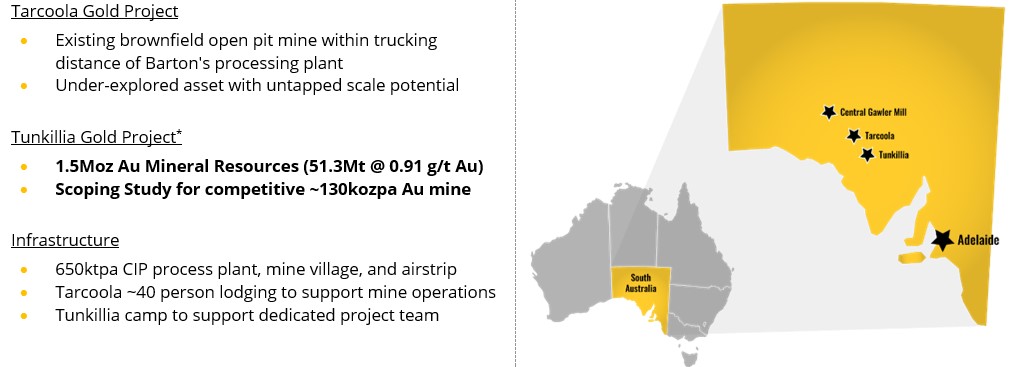
Competent Persons Statement & Previously Reported Information
The information in this announcement that relates to the historic Exploration Results and Mineral Resources as listed in the table below is based on, and fairly represents, information and supporting documentation prepared by the Competent Person whose name appears in the same row, who is an employee of or independent consultant to the Company and is a Member or Fellow of the Australasian Institute of Mining and Metallurgy (AusIMM), Australian Institute of Geoscientists (AIG) or a Recognised Professional Organisation (RPO). Each person named in the table below has sufficient experience which is relevant to the style of mineralisation and types of deposits under consideration and to the activity which he has undertaken to quality as a Competent Person as defined in the JORC Code 2012 ( JORC ).
Activity | Competent Person | Membership | Status |
Tarcoola Mineral Resource (Stockpiles) | Dr Andrew Fowler (Consultant) | AusIMM | Member |
Tarcoola Mineral Resource (Perseverance Mine) | Mr Ian Taylor (Consultant) | AusIMM | Fellow |
Tarcoola Exploration Results (until 15 Nov 2021) | Mr Colin Skidmore (Consultant) | AIG | Member |
Tarcoola Exploration Results (after 15 Nov 2021) | Mr Marc Twining (Employee) | AusIMM | Member |
Tunkillia Exploration Results (until 15 Nov 2021) | Mr Colin Skidmore (Consultant) | AIG | Member |
Tunkillia Exploration Results (after 15 Nov 2021) | Mr Marc Twining (Employee) | AusIMM | Member |
Tunkillia Mineral Resource | Mr Ian Taylor (Consultant) | AusIMM | Fellow |
Challenger Mineral Resource | Mr Dale Sims (Consultant) | AusIMM / AIG | Fellow / Member |
The information relating to historic Exploration Results and Mineral Resources in this announcement is extracted from the Company's Prospectus dated 14 May 2021 or as otherwise noted in this announcement, available from the Company's website at www.bartongold.com.au or on the ASX website www.asx.com.au . The Company confirms that it is not aware of any new information or data that materially affects the Exploration Results and Mineral Resource information included in previous announcements and, in the case of estimates of Mineral Resources, that all material assumptions and technical parameters underpinning the estimates, and any production targets and forecast financial information derived from the production targets, continue to apply and have not materially changed. The Company confirms that the form and context in which the applicable Competent Persons' findings are presented have not been materially modified from the previous announcements.
Cautionary Statement Regarding Forward-Looking Information
This document may contain forward-looking statements. Forward-looking statements are often, but not always, identified by the use of words such as "seek", "anticipate", "believe", "plan", "expect", "target" and "intend" and statements than an event or result "may", "will", "should", "would", "could", or "might" occur or be achieved and other similar expressions. Forward-looking information is subject to business, legal and economic risks and uncertainties and other factors that could cause actual results to differ materially from those contained in forward-looking statements. Such factors include, among other things, risks relating to property interests, the global economic climate, commodity prices, sovereign and legal risks, and environmental risks. Forward-looking statements are based upon estimates and opinions at the date the statements are made. Barton undertakes no obligation to update these forward-looking statements for events or circumstances that occur subsequent to such dates or to update or keep current any of the information contained herein. Any estimates or projections as to events that may occur in the future (including projections of revenue, expense, net income and performance) are based upon the best judgment of Barton from information available as of the date of this document. There is no guarantee that any of these estimates or projections will be achieved. Actual results will vary from the projections and such variations may be material. Nothing contained herein is, or shall be relied upon as, a promise or representation as to the past or future. Any reliance placed by the reader on this document, or on any forward-looking statement contained in or referred to in this document will be solely at the readers own risk, and readers are cautioned not to place undue reliance on forward-looking statements due to the inherent uncertainty thereof.
JORC Table 1 - Tarcoola Gold Project
Section 1 Sampling Techniques and Data
Criteria | Commentary |
|---|---|
Sampling techniques Nature and quality of sampling (e.g. cut channels, random chips, or specific specialised industry standard measurement tools appropriate to the minerals under investigation, such as down hole gamma sondes, or handheld XRF instruments, etc.). These examples should not be taken as limiting the broad meaning of sampling. Include reference to measures taken to ensure sample representivity and the appropriate calibration of any measurement tools or systems used. Aspects of the determination of mineralisation that are Material to the Public Report. In cases where 'industry standard' work has been done this would be relatively simple (e.g. "RC drilling was used to obtain 1 m samples from which 3 kg was pulverised to produce a 30 g charge for fire assay"). In other cases, more explanation may be required, such as where there is coarse gold that has inherent sampling problems. Unusual commodities or mineralisation types (e.g. submarine nodules) may warrant disclosure of detailed information | Sampling during Barton Gold's RC drill programs at Tarcoola was obtained through reverse circulation (RC) and diamond drilling methods. Historic RC and diamond drilling methods were also used in drilling campaigns completed since the mid-1990s. Rotary air-blast (RAB) and aircore drilling has also been completed. These holes were used to guide interpretation but were not used for previous grade estimations or modelling of the results reported in the accompanying Announcement. The drilling program used a Metzke cone splitter (or similar) attached to the cyclone. One-metre splits were constrained by chute and butterfly valves to derive a 2-4kg split on the cyclone. Samples above 1m depth were not collected. Diamond core for drilling has been sawn in half using an automated core saw. Field duplicates were derived from using quarter core for the designated interval. Historic diamond core has been sawn in half or quarter using a core saw. Historic RC samples were collected using various splitting methods over the project's history. A splitter was generally used; however, spear samples were taken for a period of time in some holes. The sample preparation for drilling conducted in 2023 and 2024 of the one-metre sampling for Barton Gold's RC and diamond drill program was conducted by Bureau Veritas (Adelaide) using method FA1 where the 2-3kg split sample received at the laboratory is weighed, dried, crushed to 10mm, pulverized to 75 micron and split to provide a 40g sample for fire assay analysis. The sample preparation of the one-metre sampling for Barton Gold's 2021 RC drill program was conducted by Intertek Genalysis (Adelaide) using method SP1 where the 2-3kg split sample received at the laboratory is weighed, dried, crushed to 3mm, pulverized to 75 micron and split to provide a 50g sample for fire assay and adequate pulverized material for possible future multi-element analysis. Historically RC and diamond drilling samples were analysed by various laboratories by either fire assay or Aqua Regia digest, detection by atomic absorption spectrometry (AAS) or a Pulverise and Leach (PAL) process. 1 m RC or diamond samples were generally collected. |
Drilling techniques Drill type (e.g. core, RC, open-hole hammer, rotary air blast, auger, Bangka, sonic, etc.) and details (e.g. core diameter, triple or standard tube, depth of diamond tails, face-sampling bit or other type, whether core is oriented and if so, by what method, etc.). | The RC drilling by Barton Gold used a face-sampling 5 ¾" RC drilling techniques undertaken by Profile Drilling. Profile Drilling used an air delivery systems comprising primary and auxillary compressor plus booster, delivering nominal air capacities of approximately 1000psi/2000cfm. Historic drilling has taken place over numerous periods since the mid- 1980s as follows:
|
Drill sample recovery Method of recording and assessing core and chip sample recoveries and results assessed. Measures taken to maximise sample recovery and ensure representative nature of the samples. Whether a relationship exists between sample recovery and grade and whether sample bias may have occurred due to preferential loss/gain of fine/coarse material. | Drilling recoveries were qualitatively described for each drilled interval in the field database along with an estimation of moisture content. In general recoveries were good in the order of 30-40kg for each one-metre interval of RC drilling and less than 1% of intervals noted any moisture content. Samples submitted to the laboratory were weighed on a dry, as-received basis and reported along with assay results. No relationship between grade and recovery has been identified. Drilling recoveries prior to 2012 were not recorded for both RC chips and diamond core. Some earlier reports noted difficult drilling. Grenfell noted that care was taken to maximise recoveries and minimise contamination and wet drilling conditions were not often encountered. AngloGold noted no major problems with drilling conditions. TGL RC drilling programmes noted good recoveries, with weights of 30-40kg achieved in fresh material. Within the weathered zone, sample weights were more variable. Holes collared in the Quaternary overburden yielded poor or no recovery from the upper unconsolidated cover sequence, which does not host gold mineralisation. Diamond core recoveries were recorded by TGL. Local zones of core loss were noted in the oxide zone however core recoveries were generally good. The RC drilling was closely monitored by the site geologist to ensure optimal recovery and that samples were considered representative. Historically, HQ triple tube (HQ3) drilling was used for some holes to maximise core recovery. Re-entry holes were not triple-tubed as they were drilled straight into fresh bedrock. Drilling rates were controlled, and short drill runs were often used through the oxide zone to maximise core recovery. |
Logging Whether core and chip samples have been geologically and geotechnically logged to a level of detail to support appropriate Mineral Resource estimation, mining studies and metallurgical studies. Whether logging is qualitative or quantitative in nature. Core (or costean, channel, etc.) photography. The total length and percentage of the relevant intersections logged. | The RC drilling program electronically logged a number of parameters direct into a database including: Stratigraphy, lithology, weathering, primary and secondary colour, texture, grainsize, alteration type-style-intensity and mineralisation type-style-percentage. Logging practices varied over the project's history, however AngloGold attempted to standardize the logging by relogging holes in 2002. Approximately 17,000m of diamond and RC drilling and conversion of historical data into a consistent coding system. Some inconsistency in the logging is evident in the current database, however significant mapping has been completed in the pit which, in conjunction with the logging, provides a sound geological basis to prepare a Mineral Resource estimate. Logging from drilling is generally qualitative in nature. All diamond core and RC drilling has been geologically logged. |
Subsampling techniques and sample preparation If core, whether cut or sawn and whether quarter, half or all core taken If non-core, whether riffled, tube sampled, rotary split, etc. and whether sampled wet or dry. For all sample types, the nature, quality and appropriateness of the sample preparation technique. Quality control procedures adopted for all subsampling stages to maximise representivity of samples. Measures taken to ensure that the sampling is representative of the in-situ material collected, including for instance results for field duplicate/second-half sampling. Whether sample sizes are appropriate to the grain size of the material being sampled. | SADME (1964) - Diamond holes were quarter-cored by Grenfell. Aberfoyle (1979-1985) - Samples of open holes TP001-021 were collected in a PVC bag via a cyclone, and then split downto approximately 1.5kg. Newmex Exploration Limited/Tarcoola Gold Ltd (1987-1988) - RC samples from TRC001-TRC025 were collected over 1m intervals via a cyclone with an incorporated splitter. Approximately 3kg was collected for analysis. RC samples from TRC026-TRC138 were collected over 1m intervals and riffle split to collect a sample. The weight of the sample was approximately 2kg. BHP (1987-1989) - RC holes were sampled at 1m intervals with rock chips homogenized via a cyclone before being split and sampled. A 4m composite sample weighing approximately 2.5kg was initially submitted for analysis. The 1m samples were only submitted if the original 4m sample returned a value of >0.5 g/t Au. Diamond core was apparently half-cored, with samples generally taken at 1m intervals. Grenfell (1991-1993) - RC holes were sampled at 1m intervals were collected in full in plastic bags. The plastic bags were rolled several times to help ensure mixing prior to collecting a 1-2kg sample using a short plastic tube inserted diagonally several times into the material. A 4 m composite was initially submitted for analysis. 1m samples were only submitted if the original 4m sample returned a value of >0.3 g/t Au. Diamond core was apparently half-cored, with samples generally taken at 1m intervals. Grenfell (1995-1997) - RC holes were sampled at 1m intervals were collected in full in a plastic bucket, and then poured through a three-tier riffle splitter. Buckets were emptied through the splitter at 0.5m intervals. A 3kg sample was collected in a calico bag for assay, and the remaining sample collected in a large plastic bag. Poor sample recovery was apparently only noted within a small number of drillholes. Diamond core was apparently half-cored, with samples generally taken at 1m intervals. AngloGold (2001-2002) - RC holes were sampled at 1m intervals. Detail surrounding the RC subsampling techniques was not provided to CSA Global. Diamond core was apparently half- cored, with samples generally taken at 1m intervals. Subsampling is performed during the preparation stage according to the assay laboratories' internal protocols. During the RC drilling program primary samples were collected from a shute on the cyclone splitter. Field duplicates were obtained from a secondary shute on the splitter. To the best of the Competent Persons knowledge, no RC field duplicates were taken prior to 1995. After 1995, field duplicates have generally been inserted in the sample stream at a rate of one in every 20 samples. No data was provided for the AngloGold drilling program however (2001-2002). Results generally give confidence in sampling procedures . Sample sizes are considered to be appropriate to the grain size of the material being sampled. |
Quality of assay data and laboratory tests The nature, quality and appropriateness of the assaying and laboratory procedures used and whether the technique is considered partial or total. For geophysical tools, spectrometers, handheld XRF instruments, etc., the parameters used in determining the analysis including instrument make and model, reading times, calibrations factors applied and their derivation, etc. Nature of quality control procedures adopted (e.g. standards, blanks, duplicates, external laboratory checks) and whether acceptable levels of accuracy (i.e. lack of bias) and precision have been established. | Analytical techniques have varied somewhat over the projects history and are summarised below. SADME (1964) - Diamond holes were sent to Amdel in Adelaide for analysis by Aqua Regia digest flame AAS with a 0.02 detection limit. Any samples returning grades >1 g/t Au were re-assayed by fire assay with an AAS finish. Aberfoyle Exploration (1985-1987) - Samples were submitted to Classic Laboratories in Perth for fire assay using a 50g charge. Newmex Exploration Limited, Tarcoola Gold Limited (1987- 1988) - Samples from TRC001-TRC025 were submitted to Genalysis in Perth for analysis using Aqua Regia digest and AAS finish after roasting to oxidise sulphides. Fire assay was carried out on all samples containing >1 g/t Au determined following Aqua Regia. Samples from TRC026-TRC138 were submitted to Classic Comlabs, Adelaide for analysis by fire assay. BHP Gold (1988-1991) - Samples were submitted to Amdel Laboratories in Adelaide for analysis. The analytical method is not known. Queens Road Mine/Grenfell Resources (1992-1994) - Samples were submitted to Amdel for digest by Aqua Regia (two parts hydrochloric acid to one-part nitric acid), followed by extraction into organic solvent (D.I.B.K.). A 50g subsample was then analysed by AAS with a 0.02 g/t Au detection limit. Grenfell Resources (1996-1998) - Earlier samples were submitted to Amdel for analysis by Aqua Regia digest with AAS finish. Any samples returning grades >1 g/t Au were re-assayed by fire assay with and AAS finish. Later holes were submitted to Aqua Regia digest with graphite furnace AAS. AngloGold, Gravity Capital Limited (2001-2002) - Earlier holes (up to TCRC0029) were submitted to Genalysis in Adelaide. Sample preparation was completed in Adelaide, and then sample analysis was completed in Perth via a 50g fire assaywith AAS finish (Method FA50/AAS). Later holes were submitted to Analabs in Perth for analysis by fire assay. Low Impact Diamond Drilling Services (2008) - Two core holes were submitted to Onsite Laboratory Services, Bendigo for analysis by 25g fire assay with AAS finish. Subsampling techniques are not known. Tunkillia Gold (2012) - Au analysis was completed by IntertekGenalysis in Adelaide, via a 50 g lead collection fire assay with AAS finish to a 0.005 ppm detection limit (Method FA50/AA). Tarcoola Gold (2016-2017) - Samples were dried at 90 °C to eliminate the impact of moisture on sample processing. After drying samples are crushed via a Boyd Crusher to <10mm in size then split through a rotary splitter to produce a sub-sample. The crusher is cleaned regularly and has barren bricks crushed between sample groups to prevent contamination. Analysis is through the pulverising and leach (PAL) process. This process reflects the site mill extraction process where: each process is pulverised in aqueous solution with cyanide bearing assay tabs and a collection of assorted sized ball bearings. Each sample is pulverised for an hour, resulting in an Au-CN complex bearing solution and remnant pulverised sample, and the pulverised material is 95% passing 75 microns. Following PAL processing, samples are decanted, centrifuged and prepared for analysis in an AAS with a solvent separation with a DIBK and residence time of 20 minutes. The sample is then aspirated through the AAS to produce a reading. Barton Gold (2020) - 2-4kg splits were sent to MinAnalytical in Perth for preparation and analysis using photon assay techniques for gold and ICPOES/MS for multielement geochemistry. The received samples used MinAnalytical's PAP3502R method for preparation which included weighing before drying and crushing to 3mm. A 500g charge was split for analysis using MinAnalytical's PAAU2 photon assay method for gold which is a fully automated technique designed for the analysis of ores. It uses high energy x-rays to excite the atoms so liberation from the surrounding material is not required. The ~500g single-use jars allows for bulk analysis with no chance of cross contamination between samples. Barton Gold (2021) - 2-4kg splits were sent to Intertek Genalysis in Adelaide for preparation and analysis using 50g fire assay techniques for gold and ICPOES/MS for multielement geochemistry. Whilst preparation and some fire assays were undertaken in Adelaide Intertek also sent some batches to their Perth laboratories for analysis. Intertek's FA50/OE04 method uses a 50 g lead collection fire assay with ICP-OES / MS finish to a 0.005 ppm detection limit. Multielement samples were analysed using Intertek's method 4A/MS48 which is a 4-acid digest followed by analysis using ICP-OES and MS for 48 elements. Barton Gold (2022-present) - 2-4kg splits were sent to Bureau Veritas in Adelaide for preparation and analysis using a 40g fire assay technique for gold. Bureau Veritas' FA1 method uses a 40 g lead collection fire assay with AAS finish to a 0.01 ppm detection limit. No geophysical studies were used in this latest drilling program. Barton Gold's RC drilling program included a comprehensive QAQC component with Field Duplicates, Certified Standards (selection of OREAS CRM's considered most appropriate for expected grade and composition) and coarse blanks collectively inserted at ratio of approximately 1 in 17 primary samples. The sequencing of QC samples is tailored on the basis of preliminary (field) assaying to maximise the effect of QA. Additionally, the laboratories provided their internal QAQC which included check samples, CRM's, blanks and repeats. Analysis of the duplicate samples was variable but considered acceptable given the nature of gold mineralization associated with this project. Some significant variation was noted however this is considered consistent with the interpreted high nugget style of mineralisation. Bureau Veritas' analysis for gold using fire assay performed well with all batches falling within the +/-3SD test of the expected value for the given standards (3 OREAS CRM's). Historically, the amount of sampling and analytical QC data that has been collected has varied over the project's history. Limited sampling and analytical QC data is available to support drilling programs completed prior to 1992, which represents a relatively minor portion of the dataset. Between 1992 and 1994, the only meaningful QC data appears to be a comparison of spear and riffle split sampling results. No significant bias was noted between the methods. Between 1996 and 1998, standard results indicate no significant bias, and blank results suggest no issue with carry-over contamination. Field duplicate results reveal a reasonable amount of scatter, which implies poor sample precision, however no bias was noted. Check (umpire laboratory) assay results also revealed considerable scatter but no significant bias which further attests to the accuracy of the analytical data. It is understood no QC samples were submitted between 2001 and 2008. Tunkillia Gold used blanks to monitor carry-over contamination and no significant issues were detected. Field duplicates were used to assess sample precision, while CRMs were used to assess analytical accuracy. Some pulps were also sent to an umpire laboratory as a further check on analytical accuracy. Field duplicate results provide some confidence sample precision. The scatter which is observed is understandable given the moderate to high nugget effect evident at Tarcoola. The CRMs reasonably demonstrated the accuracy of the laboratory. Pulp repeats were higher than the original results, which did cause some concern however, given the CRM results the Competent Person had reasonable confidence in the accuracy of the primary laboratory. Tarcoola Gold collected field duplicates to monitor sample precision and submitted one main CRM to monitor analytical accuracy. The field duplicate results give some confidence in sample precision, with the scatter which is observed likely a consequence of the high-nugget nature of the mineralisation. Although only one CRM was used, no bias was noted. |
Verification of sampling and assaying The verification of significant intersections by either independent or alternative company personnel. The use of twinned holes. Documentation of primary data, data entry procedures, data verification, data storage (physical and electronic) protocols. Discuss any adjustment to assay data. | Alternative company personnel have verified significant intersections. No twinned holes were used in the course of this program. All data collected in the reported program including collar details, drilling records, sampling records and geological logs are recorded directly into spreadsheets in the field which includes comprehensive interval validation processes. Gyro downhole surveys and Assay results were provided in digital format. All relevant historical data was entered into a DataShed database where various validation checks were performed. Data was exported into an Access Database. No adjustments were made to any assay data in this release. |
Location of data points Accuracy and quality of surveys used to locate drillholes (collar and downhole surveys), trenches, mine workings and other locations used in Mineral Resource estimation. Specification of the grid system used. Quality and adequacy of topographic control. | All 2024 RC collars were sited using a Garmin hand-held GPS system, with all drill collars also picked up using a Leica DGPS system post-drilling (<0.1m accuracy). The RL was generated from the LiDAR survey collected at the completion of drilling. All Barton RC holes were downhole surveyed using an Axis Champ-Gyro system which provided measurements at 20m intervals up and down hole. Collar location and downhole survey methods have varied somewhat over the project's history. Almost all hole collars have been surveyed by GPS, DGPS or total station methods, with checks completed against the topographic DTM. Downhole survey methods have varied somewhat over the projects history and are summarised below. Aberfoyle (1979-1985) - Holes not surveyed. Set-up positions were used and are well documented. BHP (1987-1989) - Holes not surveyed. Set-up positions were used and are well documented. Grenfell (1991-1997) - A single shot Eastman camera was used, with surveys taken every 30-50m (GP, GL series). Early generation holes completed by Grenfell/Queens Road were not surveyed at the time of the drilling. Grenfell conducted a campaign of Eastman surveys for open historical holes, using Fugro Survey as a contractor. AngloGold (2001-2002) - A single shot Eastman camera was used, with surveys taken every 30-50m (TCD, TCRC series). Tunkillia Gold (2012) - A reflex Ezi-shot downhole camera was used, with readings taken every 30m for diamond holes (TADD series) and end-of-hole for RC holes (TARC series). TGL completed validation checks on the downhole surveys including consistency checks on available databases, comparison of digital databases against hard copy records, and against original Eastman camera discs, cross checks on grid to magnetic conversions and visual review. Tarcoola Gold (2016-2017) - In February 2017, Kinetic Technologies was engaged to perform a downhole optics survey for a geotechnical review. A total of seven holes were downhole surveyed for deviation using a directional survey probe. Readings were taken at 10m downhole intervals. Results showed minor lifting in holes deeper than 28m. The majority of grade control holes are drilled to 23m; hence hole deviation is not considered to be significant All site data is reported in Geocentric Datum of Australia 1994 (GDA94) and Vertical Datum in Australian Height Datum (AHD). The map projection is MGA Zone 53. Historic Survey Data has been converted to GDA94. In March 2020 Barton gold engaged Aerometrex to collect LiDAR and high-resolution ortho-imagery over the entire Tarcoola Mining Lease. All datasets are levelled to the LiDAR survey. |
Data spacing and distribution Data spacing for reporting of Exploration Results. Whether the data spacing and distribution is sufficient to establish the degree of geological and grade continuity appropriate for the Mineral Resource and Ore Reserve estimation procedure(s) and classifications applied. Whether sample compositing has been applied. | The spacing of RC drill holes was determined to provide an adequate test for mineralisation being targeted. Sample compositing was not applied |
Orientation of data in relation to geological structure Whether the orientation of sampling achieves unbiased sampling of possible structures and the extent to which this is known, considering the deposit type. If the relationship between the drilling orientation and the orientation of key mineralised structures is considered to have introduced a sampling bias, this should be assessed and reported if material. | Precise controls on the orientations of mineralisation are poorly understood outside of existing modelled zones of mineralisation. Angled drill holes were drilled due to likely steep dip expected on mineralised positions, based on mineralisation observed elsewhere in the deposit area. Further exploration is required to determine true widths and orientations of mineralisation with a greater degree of confidence. |
Sample security The measures taken to ensure sample security . | Barton Gold staff oversaw the sampling on the RC drill rig and maintained oversight of sample security whilst onsite during the drilling programs. Split samples were inserted into pre-printed calico bags. These tied bags were, in batches of 5, ziplocked into labelled poly-weave bags which were inserted into ziplocked Bulka-bags. The bulka bags were strapped onto pallets and either transported and delivered to the laboratory by Barton Gold personnel, orloaded by a Barton Gold representative on to a semitrailer for transport to the laboratories in Adelaide. The trailers were not unloaded whilst in transit. Barton does not have detailed information in regard to sample security measures taken by previous owners of the Tarcoola project. However, Barton understands that these procedures have been in accordance with commonly adopted standard industry practices |
Audits or reviews The results of any audits or reviews of sampling techniques and data | An internal peer review of the exploration data processes has been completed by Barton Gold which has included a detailed review of the assay, survey and QAQC data. MacArthur carried out a review of sampling techniques and data in 2013. Mining Plus undertook a comprehensive audit of the historical drilling database in 2020 and have in part rebuilt the database using original assay results and incorporated significant supporting metadata. |
Section 2 Reporting of Exploration Results
Criteria | Commentary |
|---|---|
Mineral tenement and land tenure status Type, reference name/number, location and ownership including agreements or material issues with third parties such as joint ventures, partnerships, overriding royalties, native title interests, historical sites, wilderness or national park and environmental settings. The security of the tenure held at the time of reporting along with any known impediments to obtaining a licence to operate in the area. | The Tarcoola ML Project area lies within Mineral Lease (ML) 6455. ML6455 covers an area of 725.35 ha and is situated completely within Exploration Licence (EL) 6210 which was owned by Tarcoola 2 Pty Ltd a wholly owned subsidiary of Barton Gold Pty Ltd. The Mining Lease is covered by a registered Native Title determination held by the Antakirinja Matu-Yankunytjatjara Aboriginal Corporation (AMYAC). Tarcoola 2 has a deed of agreement with AMYAC and all work programs have been approved by AMYAC. Adjacent to the Perseverance Deposit and the Deliverance/Eclipse Target areas are registered State Heritage Places. The Tarcoola deposit is currently held under a Mining Lease which is listed as Under Care and Maintenance. There are no known impediments to obtaining future licences. |
Exploration done by other parties Acknowledgment and appraisal of exploration by other parties. | The Tarcoola deposit has been subject to sporadic exploration by numerous parties since alluvial gold was first discovered in 1893. Companies who have undertaken drilling include: Newmex Exploration, BHP, Grenfell Resources, AngloGold, Stellar, Hiltaba Gold, Tunkillia Gold and Tarcoola Gold. |
Geology Deposit type, geological setting and style of mineralisation. | The Tarcoola Project covers a portion of the north-western Gawler Craton centred over the historic Tarcoola goldfield, where Archaean and Proterozoic rocks form the basement to an extensive cover of Phanerozoic sediments. The Archaean basement has been extensively deformed, whereas the Proterozoic rocks have been weakly to moderately deformed. At Perseverance (current Tarcoola open pit mine), gold mineralisation is hosted within sedimentary rocks of the Tarcoola Formation and granite, both of Proterozoic age. The granite is variably in fault contact with or unconformably overlain by the sediments, which consists of conglomerate, limestone, sandstone, siltstones, and shale. A suite of later intrusions (Lady Jane Diorite) cut both the sedimentary rocks and the granite. Mafic high level intrusives associated with the 1590Ma Hiltaba Magmatic Event are considered to control the spatial setting of both gold and base metal mineralisation. Three deformation events have been recognised in the area. D1 is characterised by open folding and NNW-directed thrusting, responsibly for the southerly dip of the sedimentary package at Perseverance. Steeply dipping NW and NE trending brittle faults developed during D2. These structures host and control the gold mineralisation in the Tarcoola Ridge area. The third deformation event (D3) is represented by the late E-W trending barren quartz veins. Gold has locally been remobilised and enriched in the weathering profile. The base of complete oxidation occurs typically 10-40m below surface, and the base of partial oxidation occurs at a depth of ~20-60m. Within the primary zone, sericite-quartz-pyrite alteration zones are spatially associated with the mineralisation and overprint earlier hematite-magnetite alteration. An outer halo of chlorite (+/-leucoxene and pyrite) is developed. Pyrite, galena and sphalerite are the main associated sulphide minerals, with subordinate amounts of chalcopyrite bornite and/or arsenopyrite noted. Veins can be discrete or form wider stockwork zones and are surrounded by broader quartz-sericite alteration envelopes which can host lower grade background halos of mineralisation. Dispersed supergene mineralisation in the oxide zone can be largely detached from veining. For more detail see: Budd, A & Skirrow, R, 2007. The Nature and Origin of Gold Deposits of the Tarcoola Goldfield and Implications for the Central Gawler Gold Province, South Australia. Economic Geology, 2007. |
Drillhole information A summary of all information material to the understanding of the exploration results including a tabulation of the following information for all Material drillholes:
If the exclusion of this information is justified on the basis that the information is not Material and this exclusion does not detract from the understanding of the report, the Competent Person should clearly explain why this is the case. | A tabulation of the drilling program including the details of historic holes mentioned in this Announcement are presented in Tables 2 to 5. |
Data aggregation methods In reporting Exploration Results, weighting averaging techniques, maximum and/or minimum grade truncations (e.g. cutting of high grades) and cut-off grades are usually Material and should be stated. Where aggregate intercepts incorporate short lengths of high grade results and longer lengths of low grade results, the procedure used for such aggregation should be stated and some typical examples of such aggregations should be shown in detail. The assumptions used for any reporting of metal equivalent values should be clearly stated. | Reported intersections used the following criteria:
No metal equivalents were calculated |
Relationship between mineralisation widths and intercept lengths These relationships are particularly important in the reporting of Exploration Results. If the geometry of the mineralisation with respect to the drillhole angle is known, its nature should be reported. If it is not known and only the down hole lengths are reported, there should be a clear statement to this effect (e.g. "downhole length, true width not known"). | The relationship between mineralisation width and intercept lengths is unknown. Mineralisation elsewhere in the broader project area where there is greater levels of geological confidence is steeply dipping. |
Diagrams Appropriate maps and sections (with scales) and tabulations of intercepts should be included for any significant discovery being reported These should include, but not be limited to a plan view of drillhole collar locations and appropriate sectional views . | See figures included in the body of this announcement |
Balanced reporting Where comprehensive reporting of all Exploration Results is not practicable, representative reporting of both low and high grades and/or widths should be practiced to avoid misleading reporting of Exploration Results. | Balanced reporting of Exploration Results is presented. Historical drilling has been undertaken across all recently drilled areas and is presented only where applicable at the scale of diagrams provided. |
Other substantive exploration data Other exploration data, if meaningful and material, should be reported including (but not limited to): geological observations; geophysical survey results; geochemical survey results; bulk samples - size and method of treatment; metallurgical test results; bulk density, groundwater, geotechnical and rock characteristics; potential deleterious or contaminating substances. | No substantive exploration data not already mentioned in this table has been used in the preparation of this Announcement. There are however extensive geological, geophysical, geochemical, geotechnical and metallurgical datasets available for this project area |
Further work The nature and scale of planned further work (e.g. tests for lateral extensions or depth extensions or large-scale step-out drilling). Diagrams clearly highlighting the areas of possible extensions, including the main geological interpretations and future drilling areas, provided this information is not commercially sensitive. | Barton Gold is planning further work which will be focused on testing for dip extensions and strike extensions and to confirm grade and geological continuity implied by the current results. Diagrams have been included in the body of this Announcement |
Table 2: Drillhole Collar Details for Barton Tarcoola Exploration Drilling (May 2024 - July 2024) programs mentioned in this announcement.
Hole ID | Easting | Northing | RL | DIP | TAZ | Total Depth (EOH) | Type* | Completion | Target |
TBM0205 | 454951 | 6602904 | 90 | -78 | 272 | 84 | RC | 19/7/2024 | SE Pit Floor |
TBM0206 | 454916 | 6602871 | 89 | -50 | 172 | 60 | RC | 19/7/2024 | SE Pit Floor Perseverance Fault |
TBM0207 | 454920 | 6602877 | 90 | -67 | 136 | 84 | RC | 20/7/2024 | SE Pit Floor Perseverance Fault |
TBM0208 | 454919 | 6602888 | 90 | -60 | 095 | 96 | RC | 20/7/2024 | SE Pit Floor Granite Fault East |
TBM0209 | 454866 | 6602790 | 85 | -67 | 123 | 108 | RC | 21/7/2024 | Granite Fault East |
TBM0210 | 454877 | 6602807 | 85 | -59 | 126 | 60 | RC | 21/7/2024 | Granite Vein South |
TBM0211 | 454883 | 6602816 | 85 | -65 | 105 | 66 | RC | 21/7/2024 | Perserverance Fault Peela Contact Granite Deeps |
TBM0212 | 454890 | 6602823 | 85 | -50 | 77 | 54 | RC | 22/7/2024 | Perserverance Fault Granite Fault East |
TBM0213 | 454930 | 6602863 | 90 | -54 | 304 | 138 | RC | 22/7/2024 | Peela Contact Granite Vein South |
TBM0215 | 454879 | 6602822 | 85 | -79 | 330 | 132 | RC | 22/7/2024 | Granite Vein South |
*RC=Reverse Circulation, DD= Diamond Core.
Table 3: Significant Intersections for Barton Gold Perseverance pit (December 2023 - April 2024) and Perseverance West (September 2023) drilling programs mentioned in this announcement 2
Hole ID | From | To | Metres 1 | Au (g/t) | Comments &/or including |
|---|---|---|---|---|---|
TBM0205 | 24 | 27 | 3 | 1.44 |
|
TBM0205 | 31 | 38 | 7 | 0.66 | including 2m @ 1.07g/t Au from 31m |
TBM0206 | 2 | 4 | 2 | 0.93 |
|
TBM0206 | 13 | 14 | 1 | 3.53 |
|
TBM0206 | 26 | 32 | 6 | 0.69 |
|
TBM0206 | 36 | 38 | 2 | 1.8 |
|
TBM0206 | 42 | 44 | 2 | 2.13 |
|
TBM0207 | 9 | 10 | 1 | 1.11 |
|
TBM0207 | 26 | 27 | 1 | 1.06 |
|
TBM0207 | 40 | 41 | 1 | 1.19 |
|
TBM0208 | 27 | 28 | 1 | 2.34 |
|
TBM0208 | 38 | 40 | 2 | 1.86 |
|
TBM0208 | 46 | 49 | 3 | 0.76 |
|
TBM0209 | 32 | 36 | 4 | 10.4 | including 1m @ 34.4g/t Au from 33m |
TBM0210 | 0 | 1 | 1 | 2.25 |
|
TBM0210 | 6 | 7 | 1 | 4.2 |
|
TBM0210 | 25 | 26 | 1 | 2.55 |
|
TBM0211 | 13 | 14 | 1 | 2.93 |
|
TBM0211 | 50 | 54 | 4 | 1.4 | including 1m @ 2.27g/t Au from 50m & 1m @ 2.49g/t Au from 53m |
TBM0211 | 58 | 63 | 5 | 0.44 | including 1m @ 2.49g/t Au from 53m |
TBM0212 | 11 | 16 | 5 | 5.94 | including 1m @ 23.8g/t Au from 12m |
TBM0212 | 24 | 25 | 1 | 1.6 |
|
TBM0213 | 2 | 3 | 1 | 2.14 |
|
TBM0213 | 67 | 74 | 7 | 9.63 | including 2m @ 28g/t Au from 68m |
TBM0213 | 86 | 87 | 1 | 1.36 |
|
TBM0215 | 39 | 45 | 6 | 6.17 | including 2m @ 13.4g/t Au from 40m |
TBM0215 | 62 | 65 | 3 | 2.65 |
|
TBM0215 | 74 | 77 | 3 | 2.83 |
|
TBM0215 | 83 | 86 | 3 | 1.59 |
|
TBM0215 | 99 | 104 | 5 | 6.07 | including 1m @ 28.3g/t Au from 103m |
1 Note - Not true widths (down hole intersections).
2 Note - Primary intervals calculated by applying a 0.5g/t Au cut-off (minimum 1gram-metre accumulation) and allowing up to 2m internal dilution. Included intervals are selected to ensure balanced and representative reporting of mineralisation within primary intervals.
Table 4: Drillhole Collar Details for Historical Drill Holes Mentioned in this Announcement
Hole ID | Easting | Northing | RL | DIP | TAZ | Total Depth (EOH) | Type* | Completion | Target |
GP005D | 454793 | 6602749 | 164 | -58 | 65 | 279 | DDH | 15/04/1996 |
|
GP033RD | 454807 | 6602872 | 157 | -61 | 113 | 274.2 | RCD | 10/03/1997 |
|
QR024 | 454911 | 6602769 | 164 | -90 | 0 | 144 | RC | 1/01/1993 |
|
QR093 | 454835 | 6602820 | 161 | -90 | 0 | 60 | RC | 16/04/1993 |
|
QR116 | 454898 | 6602740 | 164 | -60 | 331 | 125 | RC | 20/04/1993 |
|
QR158 | 454903 | 6602860 | 160 | -61 | 235 | 80 | RC | 18/08/1993 |
|
QR197 | 454817 | 6602786 | 165 | -57 | 32 | 77 | RC | 13/09/1993 |
|
TBM0035 | 454773 | 6602927 | 152 | -60 | 133 | 318 | RC | 18/08/2020 |
|
TGC0407 | 454834 | 6602804 | 135 | -60 | 0 | 23 | RC | 1/07/2017 | Grade Control |
TGC0411 | 454839 | 6602799 | 135 | -60 | 0 | 23 | RC | 1/07/2017 | Grade Control |
TGC0412 | 454839 | 6602809 | 135 | -60 | 0 | 23 | RC | 1/07/2017 | Grade Control |
TGC0792 | 454903 | 6602784 | 120 | -60 | 270 | 45 | RC | 1/01/2018 | Grade Control |
TGC1158 | 454904 | 6602776 | 100 | -60 | 270 | 24 | RC | 1/06/2018 | Grade Control |
TGC1166 | 454897 | 6602781 | 100 | -60 | 270 | 26 | RC | 1/06/2018 | Grade Control |
TGC1199 | 454922 | 6602821 | 100 | -60 | 270 | 32 | RC | 1/06/2018 | Grade Control |
TGC1202 | 454907 | 6602826 | 100 | -60 | 270 | 23 | RC | 1/06/2018 | Grade Control |
TGC1274 | 454847 | 6602806 | 100 | -90 | 0 | 42 | RC | 1/06/2018 | Grade Control |
TQ001 | 454843 | 6602796 | 163 | -60 | 106 | 100 | RC | 1/09/1991 |
|
*RC=Reverse Circulation, RCD=Reverse Circulation with Diamond Core tail, RAB=Rotary Air Blast
Table 5: Significant Intersections for Historical Drilling Mentioned in this Announcement 2
Hole ID | From | To | Metres 1 | Au (g/t) | Comments &/or including |
|---|---|---|---|---|---|
GP005D | 183 | 185 | 2 | 1.64 |
|
GP005D | 190 | 191 | 1 | 11.85 |
|
GP033RD | 138 | 148 | 10 | 6.47 | Including 2m @ 22.8g/t Au from 140m |
GP033RD | 160 | 161 | 1 | 1.17 |
|
GP033RD | 166 | 177 | 11 | 0.95 |
|
QR024 | 101 | 102 | 1 | 3.65 |
|
QR093 | 44 | 45 | 1 | 3.6 |
|
QR093 | 46 | 47 | 1 | 4.1 |
|
QR116 | 101 | 103 | 2 | 13.32 | Including 1m @ 26.0g/t Au from 102m |
QR158 | 75 | 79 | 4 | 4.27 | Including 2m @ 7.48g/t Au from 75m |
QR197 | 57 | 59 | 2 | 0.8 |
|
TBM0035 | 206 | 207 | 1 | 2.36 |
|
TGC0407 | 17 | 21 | 4 | 1.04 |
|
TGC0411 | 21 | 23 | 2 | 2.29 |
|
TGC0412 | 17 | 18 | 1 | 1.11 |
|
TGC0792 | 40 | 43 | 3 | 0.77 |
|
TGC1158 | 17 | 20 | 3 | 1.22 |
|
TGC1166 | 18 | 26 | 8 | 8.93 | Including 1m @ 24.42g/t Au from 18m and including 1m @ 31.11g/t Au from 21m |
TGC1199 | 26 | 27 | 1 | 1.75 |
|
TGC1202 | 20 | 22 | 2 | 0.81 |
|
TGC1274 | 20 | 21 | 1 | 2.13 |
|
TQ001 | 90 | 99 | 9 | 5.57 | Including 1m @ 24.7g/t Au from 93m |
1 Note - Not true widths.
2 Note - Calculated applying a 0.5g/t Au cut-off and allowing up to 2m internal dilution. Included intervals are selected to ensure balanced and representative reporting of mineralisation within primary intervals.
[1] Refer to ASX announcements dated 3 / 25 July 2024
[2] Refer to ASX announcements dated 8 / 22 April and 3 / 25 July 2024
[3] Refer to ASX Announcement dated 3 July 2024
* Refer to Barton Prospectus dated 14 May 2021 and ASX announcements dated 4 March and 16 July 2024. Total Barton JORC (2012) Mineral Resources include 824koz Au (26.8Mt @ 0.96 g/t Au) in Indicated and 750koz Au (25.4Mt @ 0.92 g/t Au) in Inferred categories.
SOURCE: Barton Gold Holdings Limited
